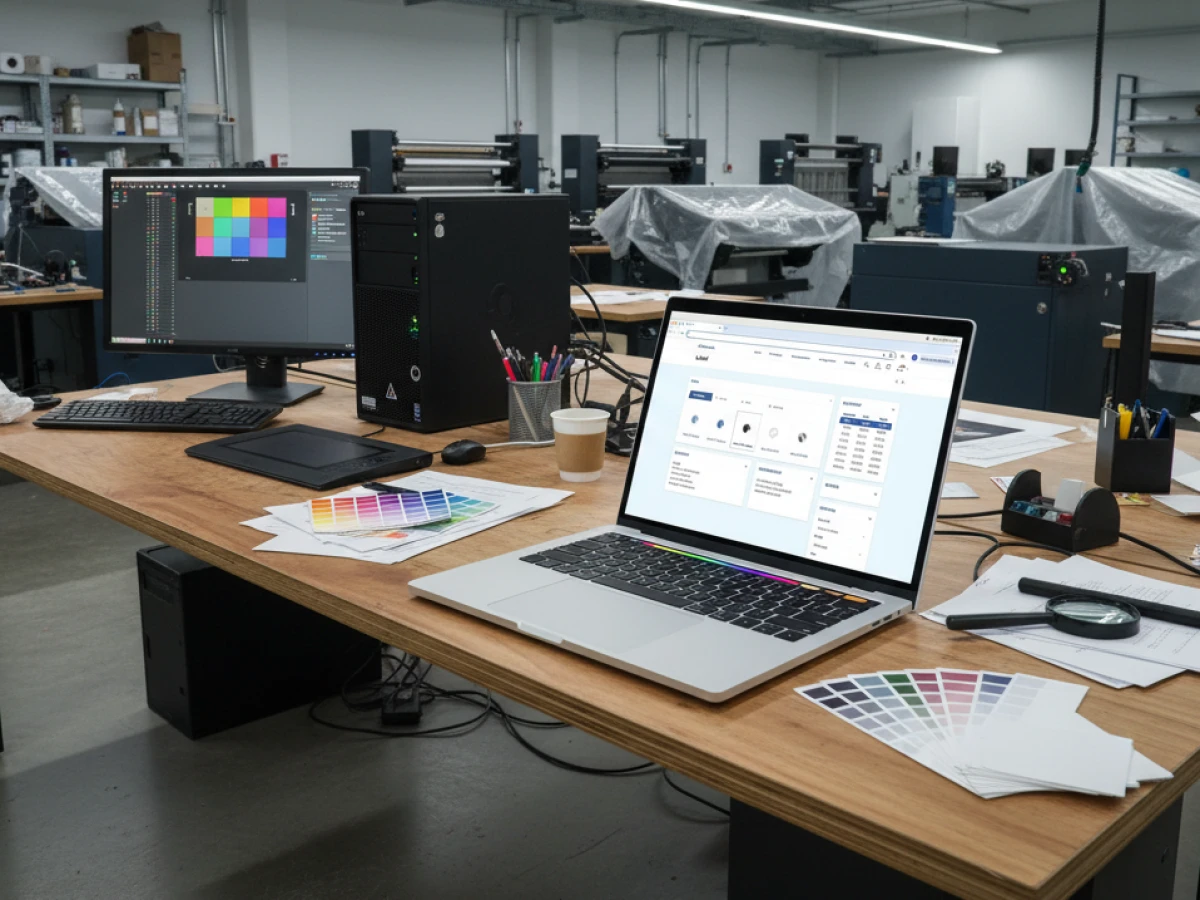How Automation in Web to Print Workflows Boosts Efficiency and Profitability
.webp)
Workflow automation is the backbone of modern web to print. By eliminating manual tasks, printers gain speed, reduce errors, and increase profitability. printQ enables fully automated workflows — from order to production — proven by references like SAXOPRINT, Druckhäusle, and Velocity Graphics.
The Pressure on Print Businesses
Today’s print industry operates under immense pressure: shorter delivery times, higher quality expectations, and lower margins. Manual processes can no longer keep up. The solution lies in workflow automation — where web to print systems move orders seamlessly from design to production without human intervention.
Automation isn’t just about efficiency. It’s about profitability, scalability, and survival in a digital-first market.
What Is Workflow Automation in Web to Print?
In traditional print, an order might involve multiple manual steps: checking files, correcting errors, generating proofs, creating print-ready files, and manually entering job tickets.
With automated web to print workflows, these tasks happen instantly:
- File preflight checks run automatically.
- Jobs are queued directly in production systems.
- Invoices, shipping, and notifications are triggered without staff involvement.
- Production-ready PDFs are generated instantly.
This process is often called “lights-out printing” — orders run through the system with minimal human touch.
Why Automation Matters
1. Cost Reduction
Every manual step adds labor costs. Automation eliminates repetitive tasks, freeing staff for high-value work.
2. Faster Turnaround
Orders move from storefront to press in minutes instead of hours or days.
3. Error Reduction
Automated preflight and data handling minimize mistakes, reducing costly reprints.
4. Scalability
Automation allows printers to process thousands of orders daily without adding staff.
5. Customer Satisfaction
Faster delivery and consistent quality lead to higher retention and loyalty.
Key Components of Automated Workflows
- Preflight Automation – Ensures uploaded files meet print specifications.
- Job Ticket Creation – Automatically generates all required production data.
- Print-Ready PDFs – Instant conversion with bleed, crop marks, and color profiles.
- ERP/MIS Integration – Links orders with inventory, billing, and production planning.
- Shipping & Invoicing – Seamlessly connected through Magento e-commerce.
- Notifications & Tracking – Automated updates keep customers informed.
How printQ Delivers End-to-End Automation
printQ stands out because automation is built into its core:
- Lights-out workflows: Routine jobs flow directly to production.
- Magento integration: Payments, shipping, and invoices handled in the same system.
- API-first architecture: Connect ERP, MIS, and production systems.
- Preflight checks: Instant file validation before production.
- Scalability: From local print shops to global enterprises with thousands of daily orders.
This means printQ isn’t just a storefront — it’s a complete automation ecosystem.
Case Studies: Automation in Action
SAXOPRINT – High-Volume Automation
SAXOPRINT processes thousands of orders daily. With printQ’s automation, routine jobs flow seamlessly from storefront to production, while staff focus on complex projects.
Druckhäusle – Efficiency Gains for SMEs
After adopting printQ, Druckhäusle significantly reduced manual tasks. Automated preflight and order handling freed staff resources, increasing profitability.
Velocity Graphics – Complex B2B Automation
Velocity Graphics needed to manage large-format menu boards for 100+ restaurants. With printQ, orders are customized online and sent directly to production — a perfect example of automation at scale.
.webp)
Best Practices for Implementing Automation
- Start small: Automate routine jobs first.
- Integrate systems: Connect ERP, MIS, and storefronts.
- Train staff: Show teams how automation frees them for higher-value work.
- Monitor results: Track time savings and error reduction.
- Scale gradually: Expand automation across all product categories.
AI and Smart Automation
The future of web to print automation goes beyond rules-based workflows. Expect:
- AI-driven preflight checks for smarter error detection.
- Predictive analytics to optimize scheduling and inventory.
- End-to-end cloud automation, connecting global production facilities.
Printers adopting these innovations will gain a decisive competitive advantage.
Innovation Made in Germany
As the creator of printQ, CloudLab stands for innovation, precision, and quality. From its headquarters in Dortmund, Germany, the company empowers print providers across the globe — from small local printers to international enterprises. The success of printQ lies in CloudLab’s ability to automate complex workflows without limiting creativity. With a clear vision for the future of online print, CloudLab transforms print production into intelligent, scalable e-commerce solutions.
Frequently Asked Questions (FAQ)
What is workflow automation in web to print?
It’s the process of moving print orders from storefront to production automatically, without manual intervention.
How does automation reduce costs?
By eliminating repetitive tasks, reducing errors, and enabling faster production.
Can small print shops benefit from automation?
Yes. Even small shops save time and money by automating routine tasks like preflight and invoicing.
How does printQ enable automation?
With built-in preflight, API integrations, Magento e-commerce, and lights-out workflows.
Is automation scalable for enterprises?
Absolutely. Enterprises like SAXOPRINT and Velocity Graphics use printQ to process thousands of orders daily.





